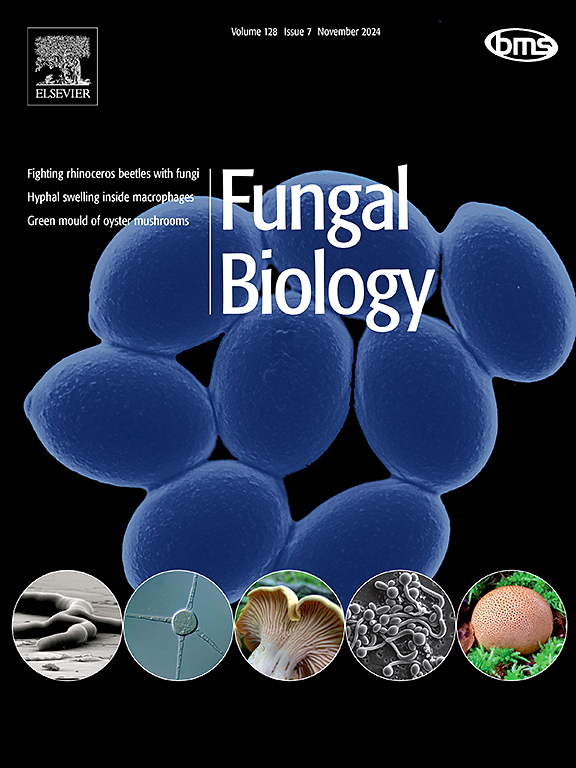A Cryptococcus neoformans polysaccharide conjugate vaccine made with filtered polysaccharide elicits protective immunity in mice
IF 3
3区 生物学
Q2 MYCOLOGY
引用次数: 0
Abstract
Diseases caused by the encapsulated fungus Cryptococcus neoformans are major causes of mortality and morbidity in immunocompromised patients. Two important cryptococcal virulence factors are the polysaccharide capsule (CPS) and the secreted exopolysaccharides (EPS), both of which contain predominantly glucuronoxylomannan (GXM) polymers. Here, we evaluated the efficacy of an experimental glycoconjugate vaccine generated by linking minimally processed cryptococcal EPS with the protein carrier CRM197. Two different adjuvants (aluminum hydroxide and Freund's adjuvant) were utilized to increase the immunogenicity and to evaluate the efficiency of vaccine protection in a mouse model of cryptococcosis. After a three-dose vaccination schedule, titers of GXM-specific antibodies and survival following lethal challenge were assessed. The protective efficacy of antibodies from sera of vaccinated mice was also evaluated in vitro, through the characterization of their enhancement of macrophage engulfment and opsonization patterns on cryptococcal cells. Antibodies elicited by the EPS-CRM197 vaccine formulated with Freund's adjuvant showed the best opsonic capabilities as shown by the macrophage engulfment analysis and cryptococcal capsule binding patterns, which was mirrored by longer survival of this vaccine group in our challenge studies. This study confirms that an EPS-protein conjugate vaccine can elicit a protective immune response in mice and provides encouragement for the development of polysaccharide–protein conjugates for the prevention of cryptococcosis.
用过滤多糖制成的新型隐球菌多糖结合疫苗在小鼠体内产生保护性免疫力
由囊化真菌新隐球菌引起的疾病是免疫功能低下患者死亡和发病的主要原因。两种重要的隐球菌毒力因子是多糖胶囊(CPS)和分泌的外多糖(EPS),两者都主要含有葡萄糖醛酸甘露聚糖(GXM)聚合物。在这里,我们评估了将最低限度加工的隐球菌EPS与蛋白质载体CRM197连接产生的实验性糖结合疫苗的功效。使用两种不同的佐剂(氢氧化铝和弗氏佐剂)来提高免疫原性,并在小鼠隐球菌病模型中评估疫苗保护的效率。在三剂疫苗接种计划后,评估gxm特异性抗体滴度和致死攻击后的生存率。通过免疫小鼠血清抗体增强巨噬细胞对隐球菌细胞的吞噬和调理模式,体外评估了免疫小鼠血清抗体的保护作用。巨噬细胞吞噬分析和隐球菌胶囊结合模式显示,用Freund佐剂配制的EPS-CRM197疫苗引发的抗体表现出最佳的抗声能力,这在我们的挑战研究中反映了该疫苗组更长的生存期。本研究证实了eps -蛋白结合疫苗可在小鼠体内引起保护性免疫应答,并为预防隐球菌病的多糖-蛋白结合物的开发提供了鼓励。
本文章由计算机程序翻译,如有差异,请以英文原文为准。
求助全文
约1分钟内获得全文
求助全文
来源期刊

Fungal biology
MYCOLOGY-
CiteScore
5.80
自引率
4.00%
发文量
80
审稿时长
49 days
期刊介绍:
Fungal Biology publishes original contributions in all fields of basic and applied research involving fungi and fungus-like organisms (including oomycetes and slime moulds). Areas of investigation include biodeterioration, biotechnology, cell and developmental biology, ecology, evolution, genetics, geomycology, medical mycology, mutualistic interactions (including lichens and mycorrhizas), physiology, plant pathology, secondary metabolites, and taxonomy and systematics. Submissions on experimental methods are also welcomed. Priority is given to contributions likely to be of interest to a wide international audience.
 求助内容:
求助内容: 应助结果提醒方式:
应助结果提醒方式:


